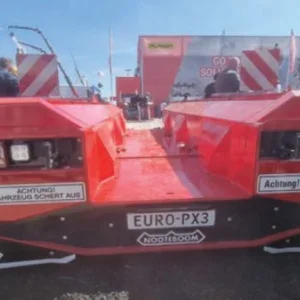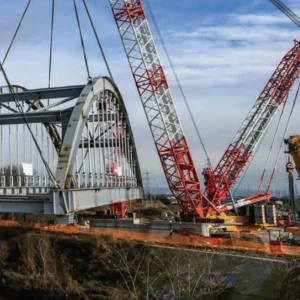The outlook is by no means clear. Many European economies, big and small, continue to struggle. Those that aren’t immediately challenged, face uncertainty as the Eurozone remains exposed to risk from its weakest members.
The latest results from crane builders add little cause for optimism. Announcing fourth quarter results, Terex said crawler and all terrain sales had slipped in Europe. Manitowoc’s Eric Etchart said that the company experienced continuing weakness in crane sales in Europe in 2011. Palfinger’s Herbert Ortner specifically pointed to the uncertainty over financial policy, saying that the knuckleboom manufacturer had observed greater restraint amongst buyers in Europe.
But, many in the industry remain determined to make the most of the opportunities Intermat presents, after almost five years without a global trade show in Europe that was not under a literal or economic cloud.
Not everyone is exhibiting this year: most noticeably, for crane buyers, Manitowoc have decided not to have a stand at the show. But many others, including many big Western names will be, and are reviewed here. Cranes Today will be there, in Hall 6, Stand A 018. We look forward to seeing you.
Terex Cranes
Along with giving delegates the chance to get up close and personal with some of its newer products, such as the Challenger 3160 all terrain and Roadmaster 5300 truckmounted crane, Terex is planning to use this year’s Intermat to launch a new self-erector product line.
Currently unnamed, the new luffing jib self-erecting tower crane will have a maximum lifting capacity of 6t at its shortest radius and will be able to lift loads of up to 1.4t at its maximum working radius of 45m.
As with the Challenger, Roadmaster and Crossover product lines, the ‘family name’ system of product nomenclature will be introduced for self-erecting tower cranes with this, the first model in the range.
The crane will also feature climbing capability along with a fully hydraulic luffing jib sections that extend from 25.5m, 28.5m, 31.5m and 34.5m along the boom. Previously the highest capacity Terex self-erector was the CBR 40H-4, capable of lifting 4t at it’s maximum radius of 40m. Now with testing on the first model in the new line complete, the new crane represents a more powerful next generation Terex self-erecting crane.
Liebherr
Liebherr will be presenting a new 4.5t capacity 65 K fast erecting crane and 160t LR 1160 crawler at its stand, in addition to drilling rigs and excavators.
The 65 K’s design is based on the design for Liebherr’s other fast erecting tower crane, 81t/m 81 K.
Its 65 K lifts 1.38t at a 40m radius and has a maximum lifting capacity of 4.43t. Loads move on two rope falls using the Speed 2 Lift function. By removing the need to rereeve, operators using the 65 K save time.
For ease of transport, the entire 65 K, along with its ballast, can be moved using two trucks.
The 65 K’s dimensions are more compact than predecessor models, with lengths smaller than 14.5m. The narrow wheel gauge of 6m allows easy manouverability.
Enabling erection close to buildings, the 65 K is designed with a very short overlap on the superstructure.
The 65 K’s low support width allows operators to use it in a compact space with a 2.55m slewing radius.
For assembly, the 65 K fast-erecting crane’s design allows very high air assembly, even over large obstacles, thanks to the semi-automatic interlock between the tower and the slewing platform.
Ballasting can be carried out rapidly without the need for an additional crane, thanks to the semi-automatic ballasting device that works with the self-centering ballast slabs.
First-time assembly can be made faster, easier and safer using the simple scaling system of the crane that has only one weight and the LCD graphics display.
The LCD display shows all the status information in pictograms that are easy to understand, Liebherr says.
Within the electronics system, Liebherr optionally offers an operating-range limiting system, fabricated by ABB, and the LMB load-moment limiting system.
The 65 K uses the drive and control technology introduced on the 81 K fast-erecting crane, previously used on top-slewing models.
Liebherr offers the fine-positioning mode called Micromove allowing operators to position heavy loads with millimetric precision without the hoist gear brake being actuated.
Stepless and especially energy-efficient FC drives, contribute to economical load handling, Liebherr says.
The fast-climbing device allows for up to five tower sections to be inserted.
With a maximum hook height of 34.6m the 65 K offers 14 heights under hook to the 30° luffed jib position, from 15.6 m to 51.7 m.
Also on the stand is the LR 1160 crawler crane. Liebherr says its LR series of crawler cranes are designed for cost-effective operation, a high level of mobility, and performance with a simplified control system, optimized drive technology, ease of transportation and assembly, and durable components.
Components such as the Liebherr diesel engine, crane winches, the undercarriage, are engineered for low maintenance requirements.
Furthermore, the Litronic control system based on Canbus technology, is standard on the LR 1160. Simultaneous motions are enabled using an electro-hydraulic continuous proportional control intended to speed working cycles.
The LR 1160 is equipped with a Tier IIIB engine. In order to fulfill the exhaust legislation in EU/USA, exhaust SCR after treatment is supported by improved engine combustion. It is designed for low fuel consumption.
The crane’s fuel consumption is also moderated by the reduced hydraulic base load, says Liebherr.
Also included are two hoist winches, each with a line pull of 12t and rope speed up to 136 m/m.
High speed winches are available as an added feature to increase hoisting speed to up to 220m per minute on cranes with either single or multiple reeving.
Equipped with an innovative self-loading and self-assembly system, the LR 1160 can be unloaded and assembled without an auxiliary crane.
Kobelco
Previously only seen as preproduction versions at ConExpo 2011, two of Kobelco’s new line of eco-friendly G-Series crawler cranes will be the Japanese manufacturer’s stand.
A fully loaded 80t CKE800G will be present to show off the range of options available, along with a similarly rigged 250t CKE25000G crawler.
The firm claims that the G-Series cranes, designed to include features that maximise fuel efficiency and CO2 emissions reduction while still retaining high operating parameters, have been very popular in Europe since their introduction last year.
Energy-saving features introduced for the G-Series cranes include an Auto-Idle-Stop function that automatically turns off the engine if it has been idling for more than ten seconds and a G-Engine that limits the maximum engine speed, for fuel efficiency, that is used in conjunction with the G-Winch to maintain a high line speed even with the engine at low revolutions.
The 250t model has done particularly well in Europe according to the manufacturer, with its 91.4m main boom, capable of luffing with a jib and maximum system length of 122m, attracting buyers across Europe. Kobelco has already sold three 250 tonners to Mammoet, with two Dutch firms P Van Ardrigen and PVE Cranes and Services taking another five and six units respectively
Sennebogen
Together with its French sales and service partner Sygmat, Sennebogen is displaying its 650 HD and 690 HD duty cycle crawlers, in addition to industrial material handling products at Hall 6, Stand D60.
Representing the duty cycle crawler crane range, the Sennebogen 650 HD will be on display with a 2,300l dragline bucket and a 50t operating weight.
The HD range contains ten models with lifting capacities of 20-180t. They are designed with motorizations from 119 to 708 kW.
The 690 HD, also on display, was launched at Intermat three years ago. Sennebogen says, "This machine has established itself extremely successfully on the market and impresses all over the world in harsh operating conditions."
Sennebogen’s duty cycle crawler cranes, known for robustness, have applications within the fields of special civil engineering, mining, demolition or material handling.
Sennebogen telescopic cranes also cover a broad range of uses, designed to be powerful and flexible all-round machines for use in construction.
From the same line, the 643 crawler crane with 40t load and 30m boom length will be on the stand, with applications particularly for lifting and positioning large loads compact spaces.
Visitors to the stand can also ask the sales team about other cranes in Sennebogen’s telescopic crane range, which includes crawler and mobile solutions with loads of 16-80 t and boom lengths of 18.8-58m.
From its industrial material handling range, Sennebogen’s 825 will be on display.
Its Green Line process machines are designed for continuous loads and high-performance material handling.
Sennebogen says that in addition to its large materials handling range it offers a variety of custom solutions thanks to the modular construction of its machines.
Combination options include undercarriage, uppercarriage, boom and cab. Electro-hydraulic drive solutions are a ‘green’ energy option.
Maeda Minicranes
Although Maeda will be showing off its full product range of minicranes in Paris this year, the company’s main focus will be on promoting the latest additions to the Maeda fleet, the 2.93t LC383M-5, the 1.72t MC174 CRM and the 2.82t MC285C-2.
An update of the company’s original MC285C mini crane, the MC285C-2 was released mid-2011, and include improvements such as a new Yanmar engine, an upgraded load moment limiter, a datalogger and a crane/outrigger interlock system.
Maeda also supply the crane with a hook block that can be configurable to accommodate either two or four falls of rope as standard.
According to Maeda the updated version of the mini crane includes design features that improve safety and simply maintenance, such as the Safety Searcher hook system and an audible alert system. The winch speed on the new crane is also improved compared to the original MC285C-2.
The LC383M-5 debuted in the European market at Bauma in 2010, after initially enjoying some success in Maeda’s domestic market of Japan.
An especially compact crane, as it has been designed without a requirement for outriggers, Maeda says the LC383M-5 is ideal for use on tight city centre development projects.
A powerful crane for its size, the LC383M-5 has a maximum capacity of 2.93t and a maximum working radius of 8.4m. It also has the capacity to be used for pick-and-carry for loads of up to 1.46t.
It features a standard blade, with a blade/crane interlock system, along with the option to use a Searcher hook.
Of the three newer Maeda mini cranes, the firm describes the MC174 CRM as the model that "sets the standard that other mini cranes try to achieve." Only 590mm wide, the crane boasts a 1.72t maximum lifting capacity along with a 5.5m maximum working height.
As well as conferring a good degree of manoeuvrability, the small dimensions of the crane help keep the ground pressure exerted by it to a minimum while remaining stable. A tilt sensor and alarm system works to warn the operator where this is not the case.
The MC174 CRM uses hydrostatic power transmission and features two travel speeds. It comes with a highspeed winch and rubber tracks as standard.
However optional extras include a liquid petroleum gaspowered version white rubber tracks, a single or two fall hook, a Searcher hook, and as with other Maeda mini cranes, a remote control option.
Penny and Giles
Penny and Giles controls from Christchurch, UK, is exhibiting its wide-ranging selection of crane controls including tilt sensors, rotary position sensors, linear position sensors and joysticks at stand 5A G53.
Penny and Giles controls are used for road construction equipment, cranes and booms, scissor lifts, agricultural vehicles, container handling and hydraulic lift systems. Many of its systems can be adapted to work under extreme operating conditions.
Penny and Guiles products on the stand include its range of rotary position sensors. The sensors provide angle measurements from 10° to 360°.
The company engineers its rotary position sensors to use Hall effect, inductive and potentiometric technologies. Devices are encased in compact or rugged housings with environmental protection, meeting standards IP68 and IP69K.
Penny and Giles linear position sensors, displacement transducers and potentiometers offer stroke lengths from 0.2" (5mm) to 196" (5000mm).
They are engineered to use potentiometric, inductive, eddy current and Hall effect technologies.
All are packaged in rugged housings with mountings offering users a range of flexible installation options.
The company’s tilt sensors measure inclination relative to earth’s gravity. They do this by using solid-state system-on-chip technology, which the company says offers advantages over fluid-based, electrolytic and pendulum-operated sensors. Advantages include as reliability, stability and compactness,
For maximum flexibility the range has a low-power requirement of less than 6.5mA, so can be used in hard-wired or battery-powered wireless systems.
The Penny and Giles range of finger-and hand-operated joystick controllers is developed for smooth, precise control of functions.
They are available in one, two or three axis configurations, and a range of selectable options, with ergonomic handle styles to enable very good proportional control.
Autec
Autec will exhibit with its Air and the Dynamic Series. A new French subsidiary will have be launched at the exhibition.
The Dynamic series for mobile hydraulic machines has recently been completed with one new transmitter and one receiver. The FJR transmitting unit combines compact dimensions (260x200x190mm) with excellent configuration options thanks to the availability of a vast range of possible actuators. The new TFT-LCD graphic display is also available, with optimised visibility for outdoor usage.
Also new in this series, the ARS receiving unit combines a CAN interface with some of the features of an analogue receiver in a compact casing, particularly fitted for installation on vehicles.
The Dynamic series has been certified for functional safety by TÜV SÜD. The Stop function complies with requirements of EN ISO 13849-1 Performance Level "e", Cat 4 and EN IEC 62061 Safety Integrity Level 3.
The UMFS (unintended movement from standstill) is compliant with PL "d", Cat. 3 / SIL2.
The first transmitter in the Air series had been launched in 4, 6, or 8 pushbutton versions. Light and compact, the new handheld unit is particularly suitable for industrial lifting applications and for automation.
Much technological advancement has been made and incorporated thanks to the completely new and highly configurable electronics.
Frequency management is a thing of the past with the AIR’s ability to identify free frequencies at the start up of the control system. Four data feedback LEDs are present on the top of the transmitter unit where machine data can be displayed. Radio frequency communication parameters can be programmed to improve reliability and safety in use.
As with any other Autec product, safety functions comply with the latest safety standard (up to PL "d", EN ISO 13849-1). A rechargeable Lithium-ion battery allows longer operation (40 hours), no memory affect, and no ageing.
Autec’s booth at Intermat will be located in Hall 5A, booth H003.
Hetronic
Hetronic’s first radio remote control to operate on the 2.4GHz frequency, the Ergo F, will be joined on the company’s stand at Intermat 2012 by a new range of products on the frequency.
Hetronic’s Ergo F was released in early 2011, and will include four new receivers — the RX ES-CAN-HL, the RX DC Mobile, the RX MFSHL DC 16-24GHz and the MLC Touch — some of which will be suitable for use with mobile hydraulic and tower cranes.
While available in three standard configurations, the Ergo F retains much of the functionality of previous handsets in the series, such as the ergonomic singlehanded operation friendly design.
It does, however add a number of other elements, like membrane switches available as single, dual or triple speed as well as Hetronic’s H-Link software.
Using H-Link software, the new transmitters and receivers can be programmed remotely, with the Ergo F programmable at a maximum distance of 20m using any pocket PC.
Hetronic’s H-Link modem allows the user to change the configuration of the Ergo-F, along with Hetronic’s new receivers, via wireless access, permitting adjustment of the frequency, timeouts and logical interlocking settings.
Hetronic say the new transmitter is reliable in the presence of a number of wireless networks thanks to the universal licence-free band on which it operates. This also makes these products suitable for in or outdoor use without the need to switch frequencies to avoid suffering disruption to functionality.
The digital, fully proportional Ergo F also features a Cat 3 PLd compliant STOP function, along with Memory Key technology that can lock out unauthorised users and remember configured settings, allowing them to be stored in backup Memory Key Caps.
Hetronic says its products on the stand feature RS232 and CANbus interfaces.
NBB Controls and Components
At Intermat 2012, NBB Controls and Components will be showcasing its entire range of products, including the full range of Planar series remotes through to the new HyPro Series of transmitters.
NBB’s HyPro 8 features up to eight single axis, proportional or stepped NBB joysticks, which the firm says feature exact switching steps on patented grids allowing a wide range of movement.
However, the firm also offers the HyPro 6 controller with six single axis joysticks, which features a bellow designed to protect the joystick when used for more rugged applications.
These joysticks on each controller are connected to the transmitter body using surface-mounted joystick technology, and this allows the easy exchange of the joysticks for replacement, in the event of damage or a fault, without requiring opening of the transmitter housing.
Transmitters in this series can operate across 147 HF channels, although this is reduced to 110 channels within Europe, and feature an automatic LBT frequency search.
The HyPro series includes a 47mm x 27mm display that has a 128 x 64 pixel resolution, but the transmitter also has the option to include other feedback data. Designed with what NBB says is a compact, ergonomic and robust housing, and featuring an integrated antenna, the HyPro series is IP65 rated for protection against environmental conditions.
Its battery is also locked inside the transmitter housing to avoid accidental removal if the controller is dropped or suffers a sudden jolt. One charging cycle of the two AA rechargeable batteries provides enough power to provide HyPro series transmitters with up to 40 hours of working time. NBB provides 7.2V rechargeable batteries and a battery charger as optional extras.
Alongside the HyPro series transmitters, NBB will display the Planar-NL, featuring up to 3 dual axis surface mounted joysticks. It will also exhibit the Planar-V4, Planar-V8 control systems, aimed at customers using NBB products for communal or forestry applications, and the Planar-B, Planar-C and Planar-D pushbutton controllers.
The controls manufacturer says that all radio remote controls and pendant remotes that NBB produces are compatible with a range CANbus interfaces, including CANOpen and J1939, as well as Profibus, RS 232 and RS 485 protocols. The firm also says that other more custom protocols present no problem for NBB’s products.
RaycoWylie
RaycoWylie, headquartered in Hastings, UK, is displaying its new all-in-one rated capacity indicator installed on a UNIC spider-crane at Intermat stand E6 B 005.
The i4500 RCI is designed to accommodate all types of cranes working in both construction and offshore industries.
RaycoWylie’s new generation of RCI, the i4500, offers a more complete integration with the crane.
It monitors advanced operational parameters, such as boom sequencing, outrigger monitoring, range limiting and windspeed.
The system can centralize safety information, engine data and camera images all on one clear, full colour display. It is compliant with European safety standard EN ISO 13849-1.
RaycoWylie’s worldwide support network offers client services internationally.
Its multilingual sales team will be on the stand to discuss the i4500 in French, English, German, Spanish,Portuguese or Italian.
RaycoWylie Systems has been involved in the design and manufacture of crane monitoring systems since 1933.
Unic Cranes Europe
Unic Cranes Europe, a specialist distributor of compact cranes for restricted access and confined working environments, will have mini spider cranes and accessories on display at its stand in exterior area 5.
The products on display will include what Unic says is the world’s smallest and lightest mini crane, the Unic URW-094, as well as the 0.995t capacity Unic URW-095 mini crane, which is only 0.6m wide.
Unic will also show its higher capacity minicranes.
The pedestrian controlled Unic URW-295 mini crane, with 3t of lifting power, will be on the stand, as well as the 4t capacity mini crane.
With the highest ‘power to weight’ ratio in its class, the 6t capacity Unic URW-706 mini crane with 19.5m lifting height will be on the stand, and the Unic URW-547 will also be on display.
Unic Cranes Europe will demo its glass manipulator head, the GL-UMC 600, for use with Unic minicrane booms.
Fly-jib crane attachments for extended reach and radio remote controls with digital feedback are also available for the GL-UMC 600 glass manipulator head. The advantage of minicranes is in their ability to work indoors and in compact worksites.
"Compact enough to fit through standard doorways for internal access, yet with the reach and strength of much larger machines, Unic minicranes are capable of lifting 0.995t to 6t with a reach of up to 22.7m," said Unic Cranes Europe.
The minicranes’ outriggers are configurable for work on uneven surfaces.
They come with different power options and safety features to prevent overloading and improve stability.
Unic Cranes Europe also provide a number of additional products which add to the versatility and functionality of Unic mini spider cranes.
The new fly jib attachments are designed to complement a number of Unic crane models to give more reach and radius when lifting over rooftops and high balustrades.
The fly jibs are able to adjust to tilt angles of 0°, 20°, 40° and 60°.
Unic Cranes Eurpoe will additionally show radio remote controls with digital feedback and graphical display. These allow operators to control Unic minicranes from a distance by displaying working radius, crane capacity and engine speed.
Trimble
Site positioning solutions provider Trimble will be at Intermat 2012, accompanied by its distributor Sitech, to showcase the firm’s suite of Connected Site solutions.
Having recently signed an agreement with Manitowoc Cranes to co-develop positioning technology and wireless communication systems aimed at improving the productivity of site lifting operations, Trimble will be demonstrating some of its existing solutions for boosting site productivity levels.
Trimble’s products enable the management and rapid wireless transfer of site data between different stakeholders on and off site using an internet-based communication portal.
This allows stakeholders to quickly communicate the most up-to-date information on a project between a company’s head office, the site office and even operators in their cabs on site.
Being able to remotely share real-time information, such as global positioning data, between the site office and cabs of construction machinery saves crane operators time by eliminating the need to go back and forth to ensure their work order information is up to date.
It also provides the main contractor greater oversight of progress on site thanks to the two-way data flow.
Data preparation is handled by Trimble’s Business Center-HCE prior to transfer to the GPS or total station positioning systems in the field that transfers the info to the crane cab.
Also, this intelligent two-way ‘live’ link allows the equipment manager to connect to assets remotely and aggregate equipment productivity and utilisation information via Trimble’s VisionLink software.






